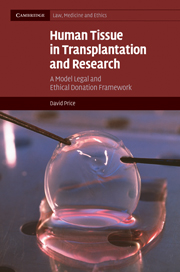Book contents
- Frontmatter
- Dedication
- Contents
- Preface
- Table of cases cited
- Table of selected statutory sources
- Introduction
- 1 Human biological materials
- 2 Interests in the living body and corpse
- 3 Eliciting wishes
- 4 Consent to donation
- 5 Presumed consent
- 6 Informed consent
- 7 Living donation
- 8 Property in human material
- Conclusion
- Index
- References
1 - Human biological materials
Published online by Cambridge University Press: 05 July 2014
- Frontmatter
- Dedication
- Contents
- Preface
- Table of cases cited
- Table of selected statutory sources
- Introduction
- 1 Human biological materials
- 2 Interests in the living body and corpse
- 3 Eliciting wishes
- 4 Consent to donation
- 5 Presumed consent
- 6 Informed consent
- 7 Living donation
- 8 Property in human material
- Conclusion
- Index
- References
Summary
This chapter is concerned with the language and concepts applied to ‘human biological materials’ for transplantation and research within the practice and policy arena, and the ambit(s) of legal regulation. The language and dialogue historically employed in this sphere has often hindered rather than assisted adequate and clear communication between professionals and lay persons. This can be seen in the repeated misapprehension attaching to the use of the term ‘tissue’ in the context of post-mortem examination and retention for research, revealed in the recent inquiry reports in the UK (‘tissue’ typically being taken by families to exclude whole organs or brains, yet having a broad generic meaning for clinicians and pathologists). Moreover, there is a need to be sensitive to the inappropriate or irreverent use of language applied to activities relating to human body parts, which might even negatively impact on rates of donation, e.g. ‘harvesting’, ‘products’, ‘cadavers’, etc. Even the expression ‘human material’ proved controversial to some consultees during the lead-up to the Human Tissue Bill being presented to Parliament, on account of the ‘objectification’ allegedly implied by the expression.
A legislative framework governing the (removal and) use of human material for medical purposes generally is currently to be found in some jurisdictions. There is, for instance, a comprehensive framework governing the use of human material for research, transplantation and other medical purposes across most of the UK, replacing the patchwork of legislative provisions previously applying to different spheres. Quite apart from the need for explicit legal authority to take, hold, or use the material itself, especially as regards deceased persons, there are concerns that need to be addressed relating to the safety and quality of material, potential limitations on use and commerciality, suitability of the personnel and premises connected with the material, etc.
- Type
- Chapter
- Information
- Human Tissue in Transplantation and ResearchA Model Legal and Ethical Donation Framework, pp. 26 - 42Publisher: Cambridge University PressPrint publication year: 2009



